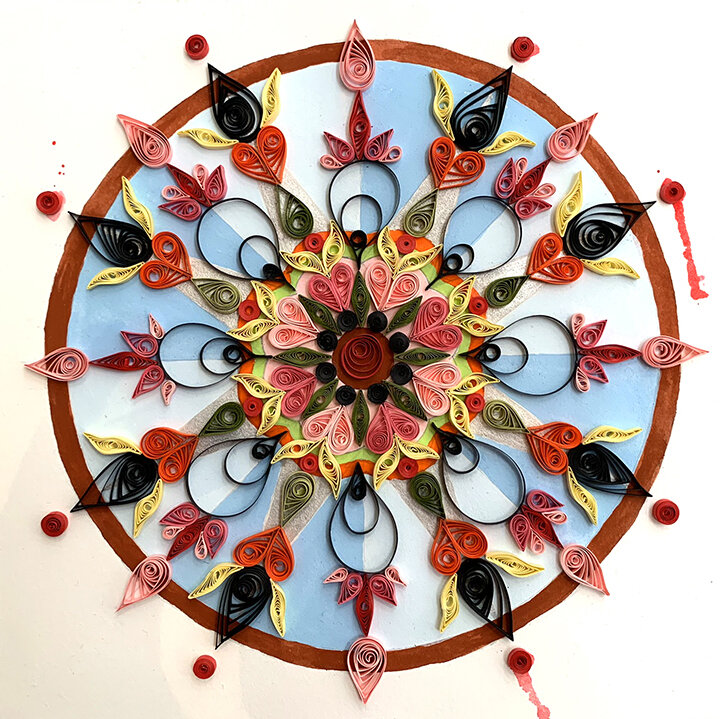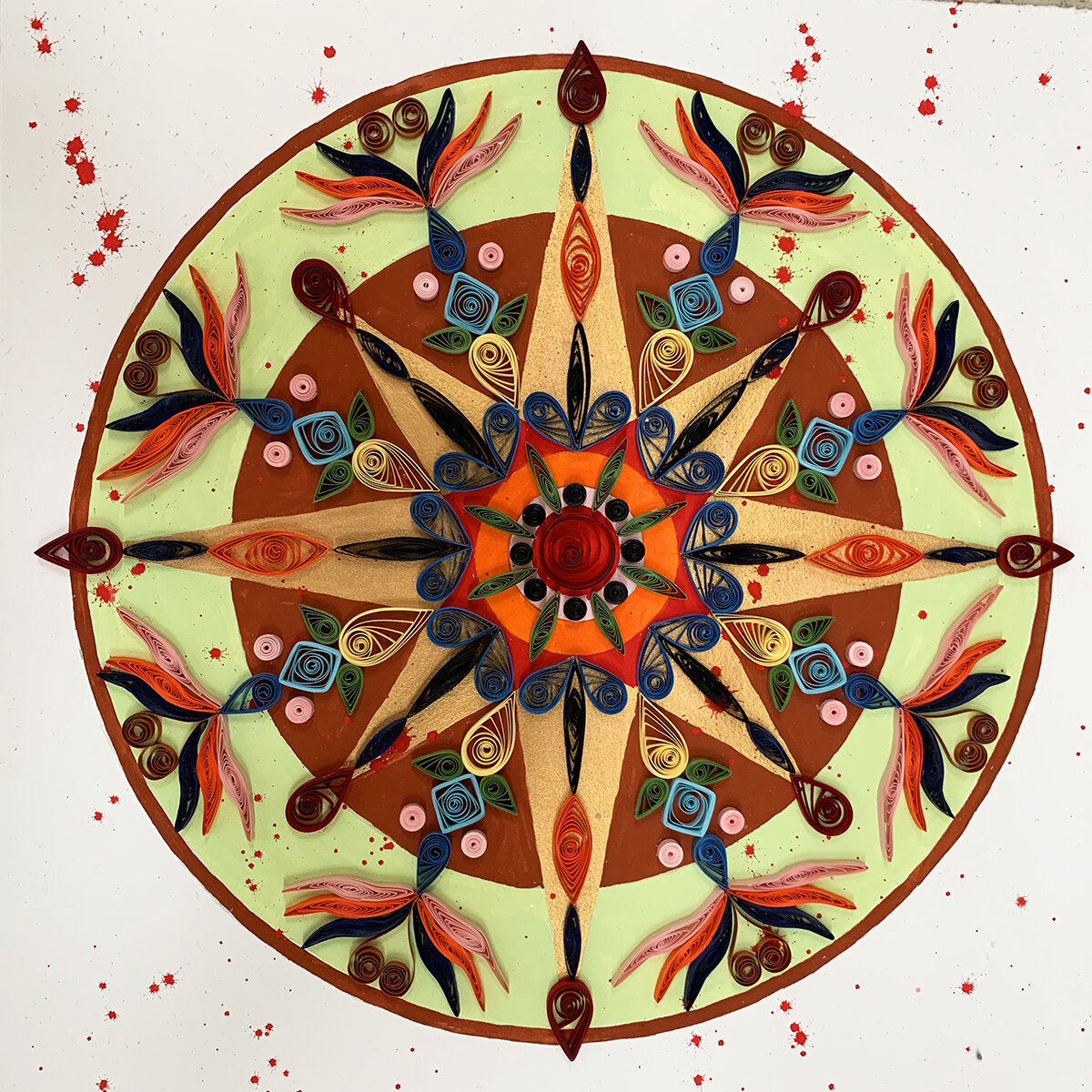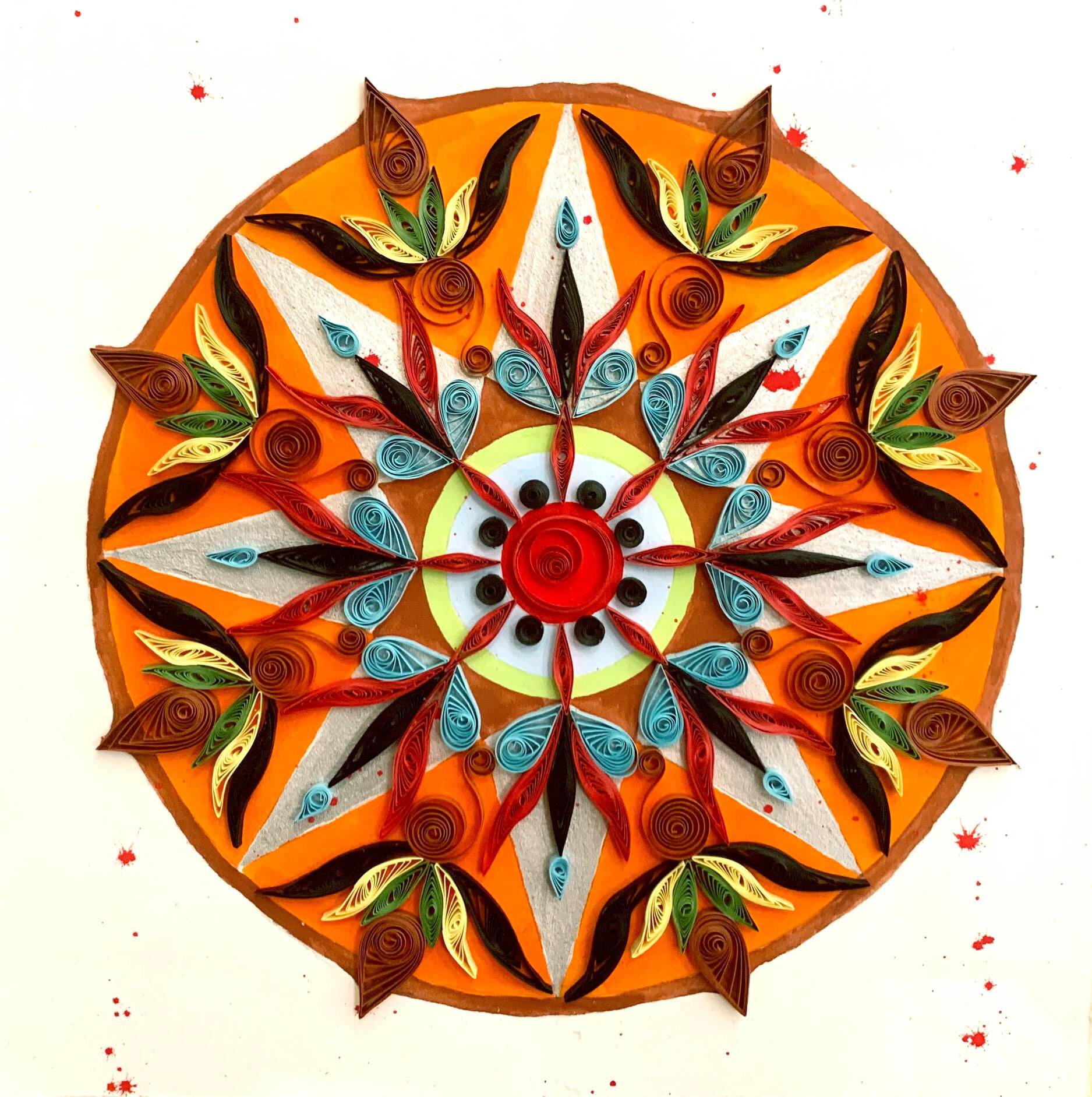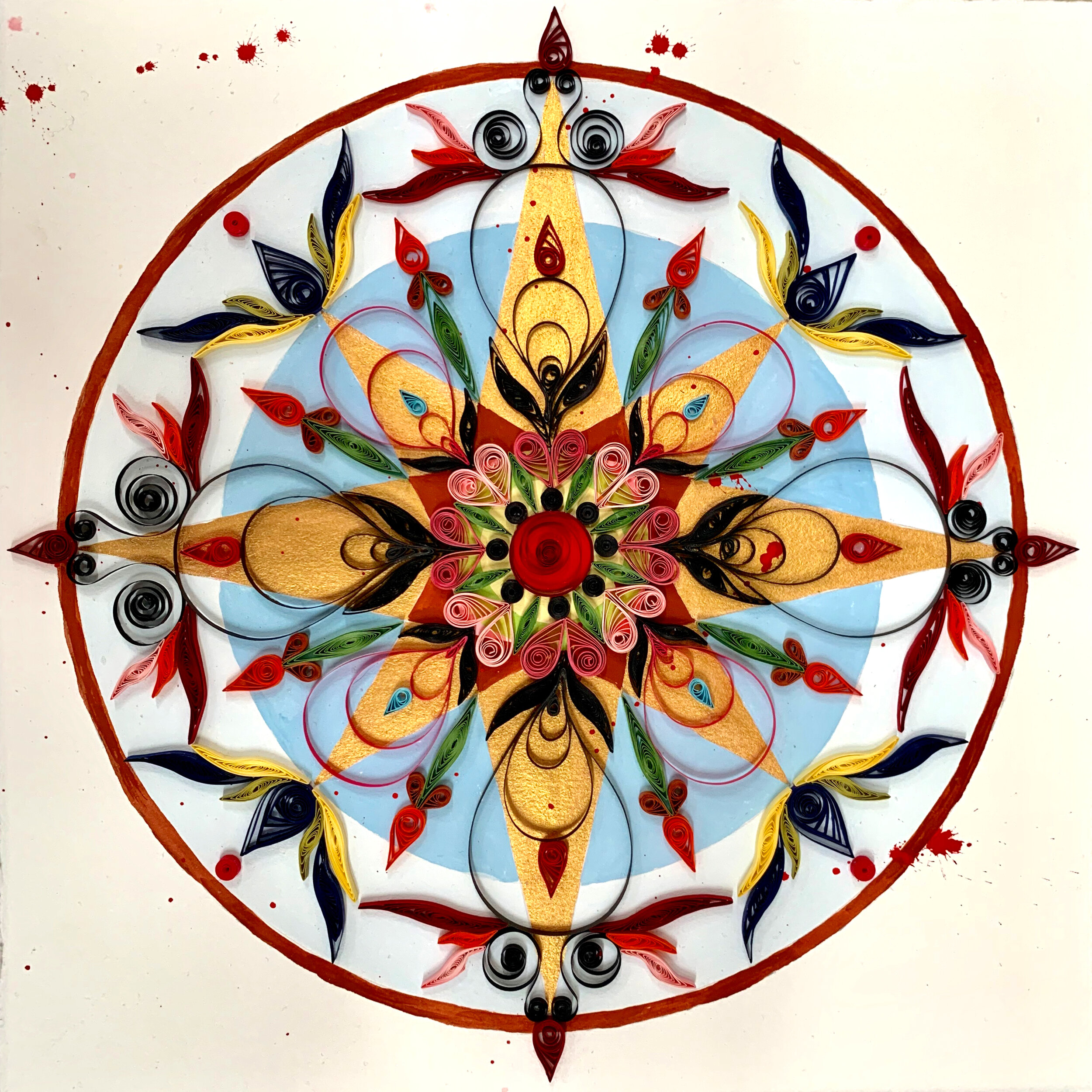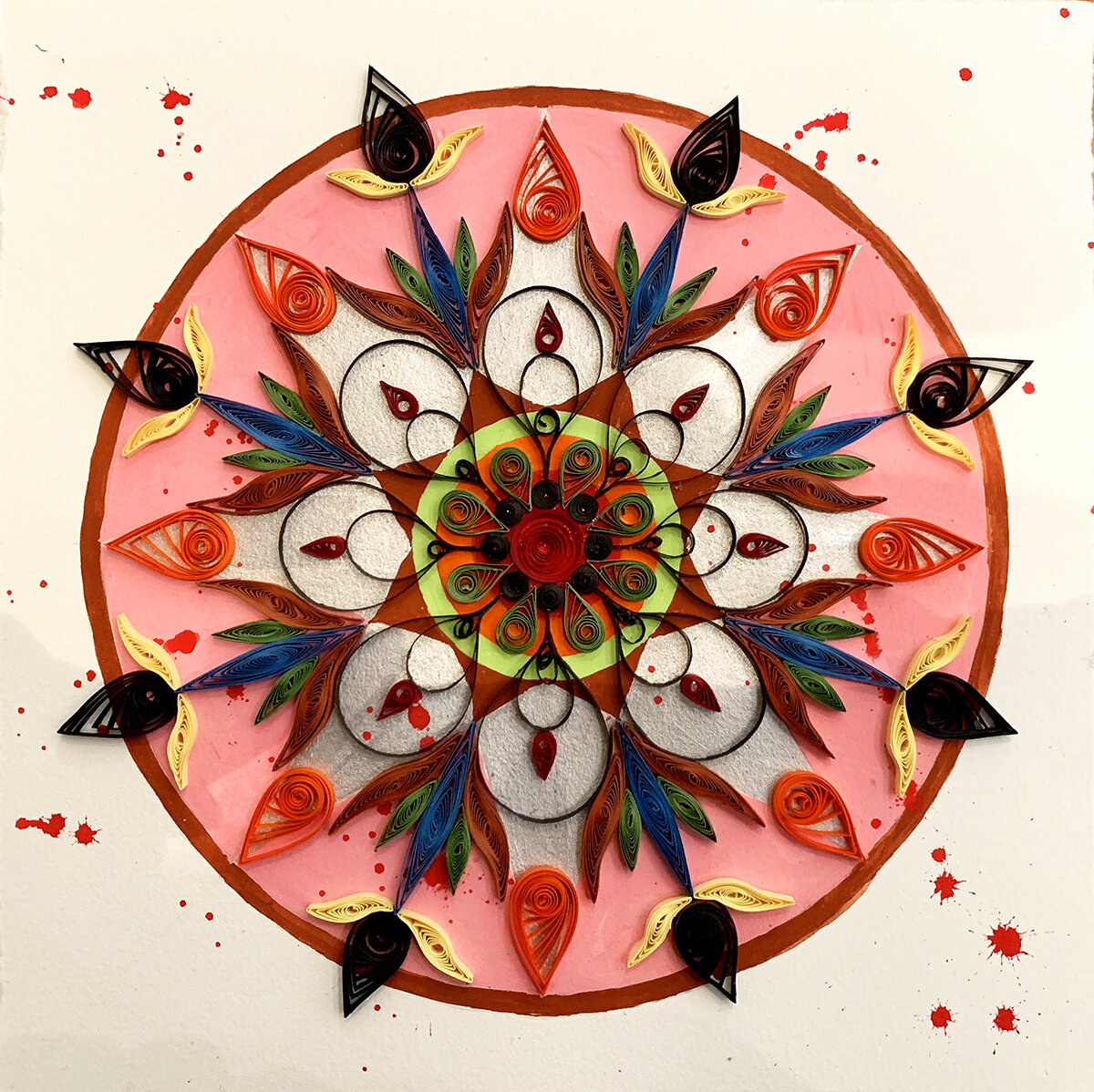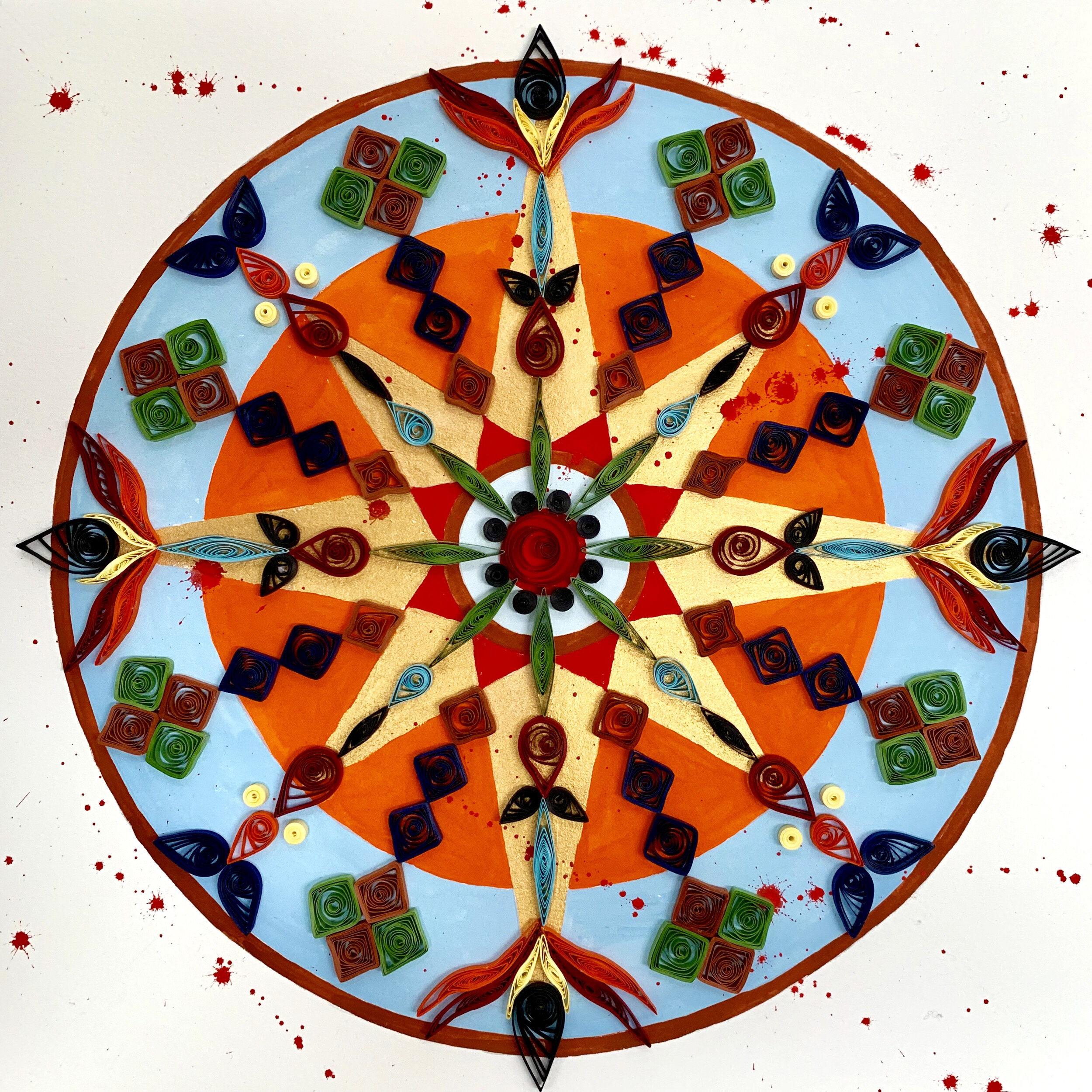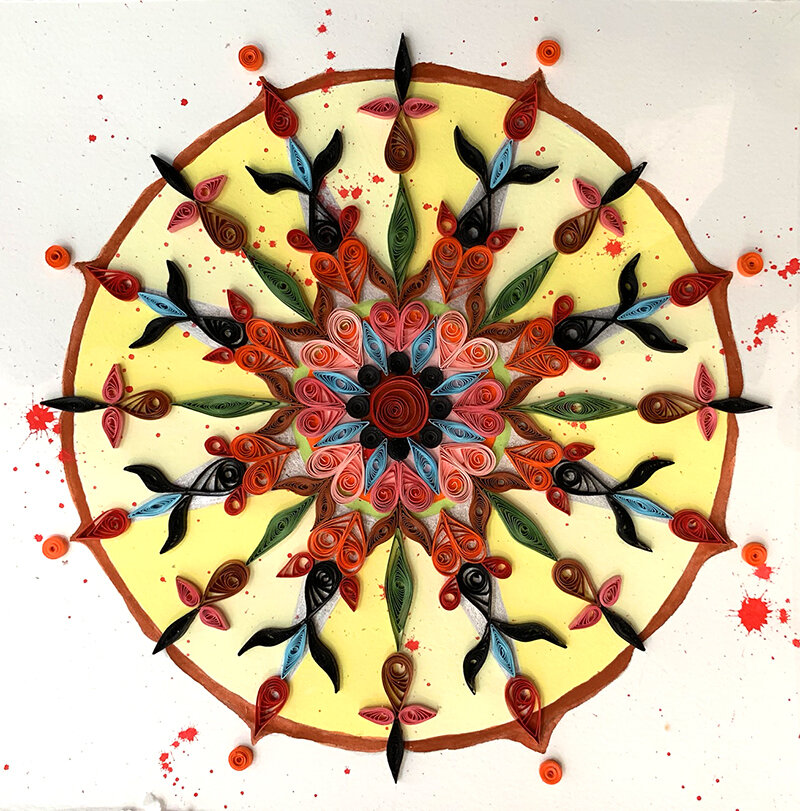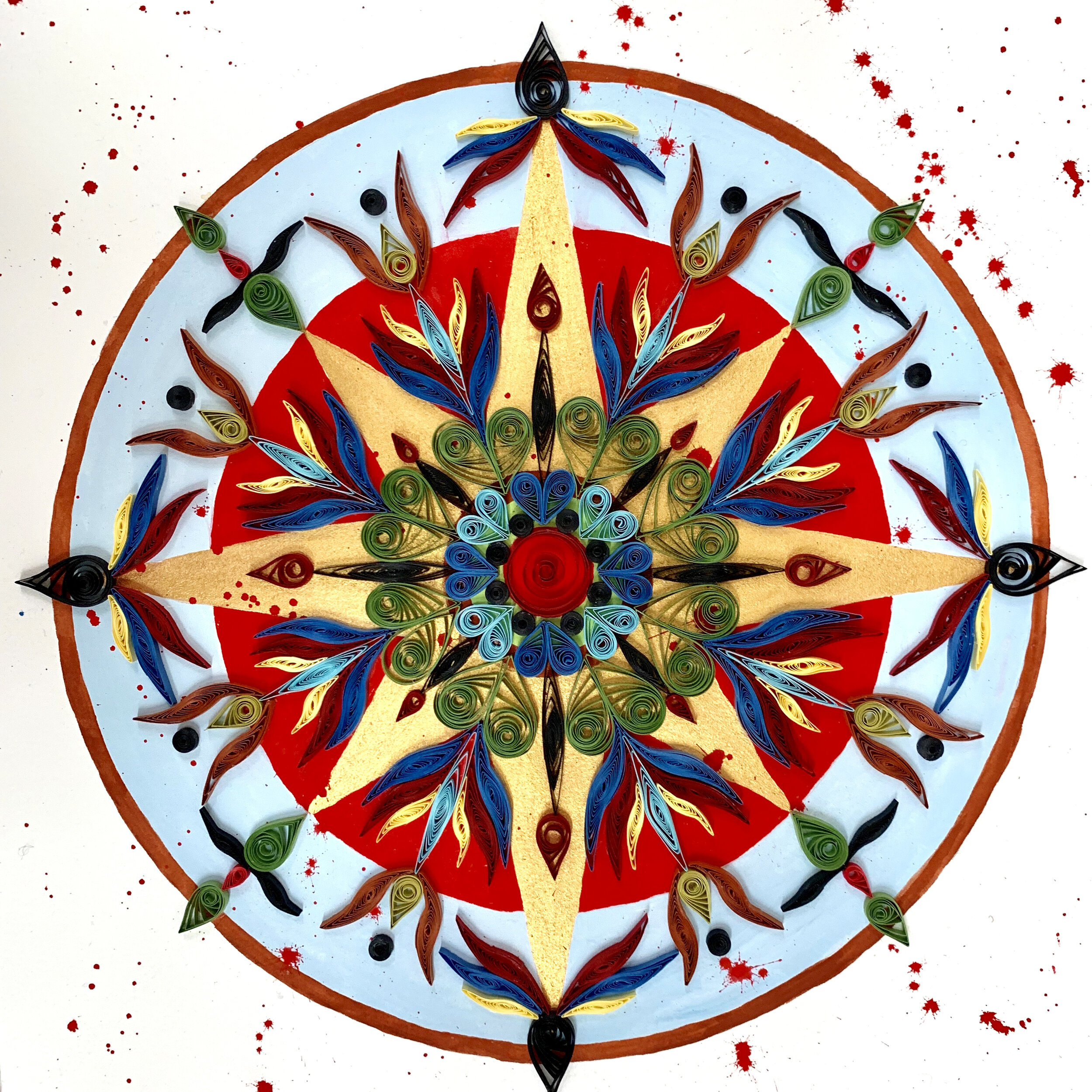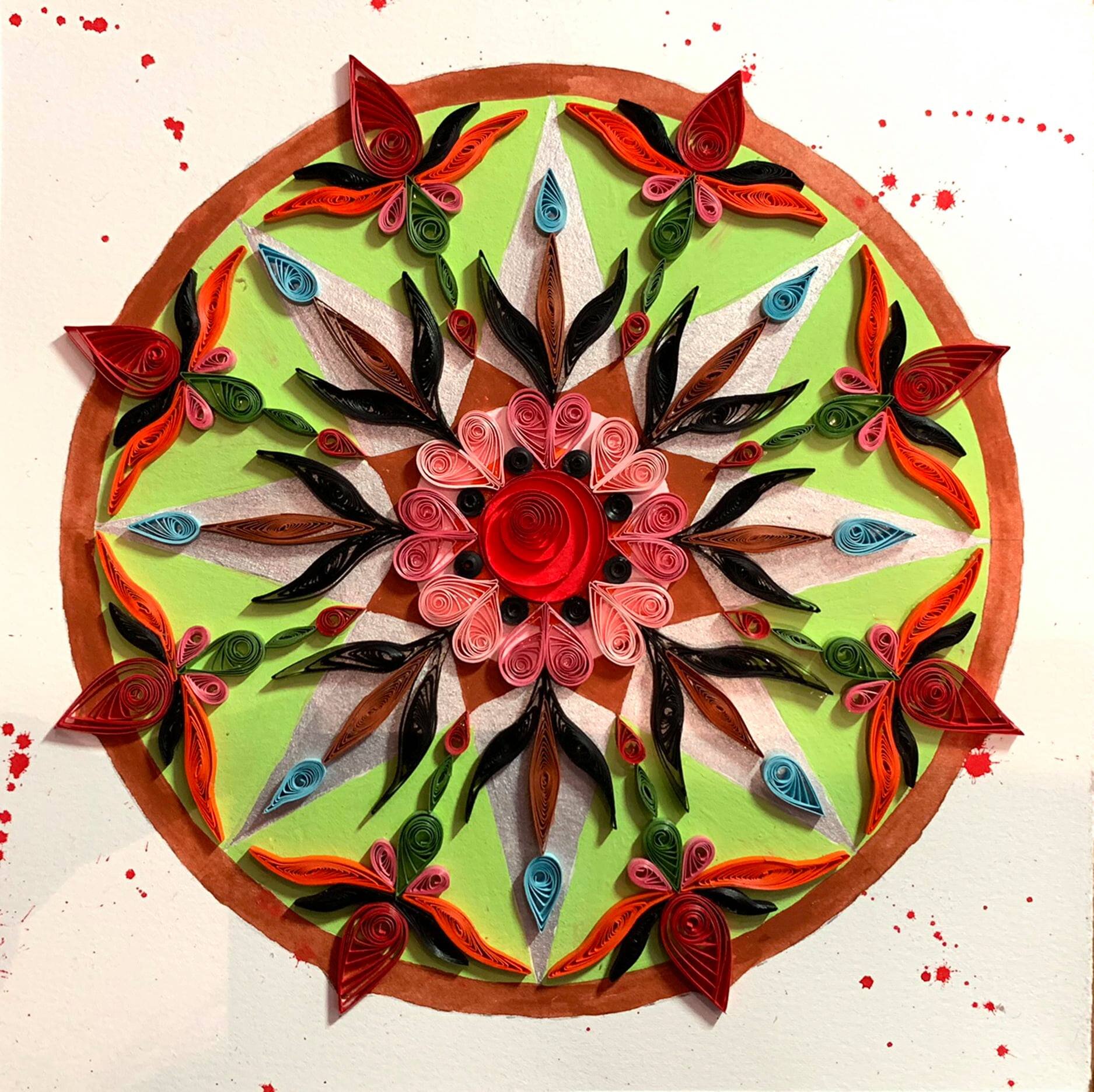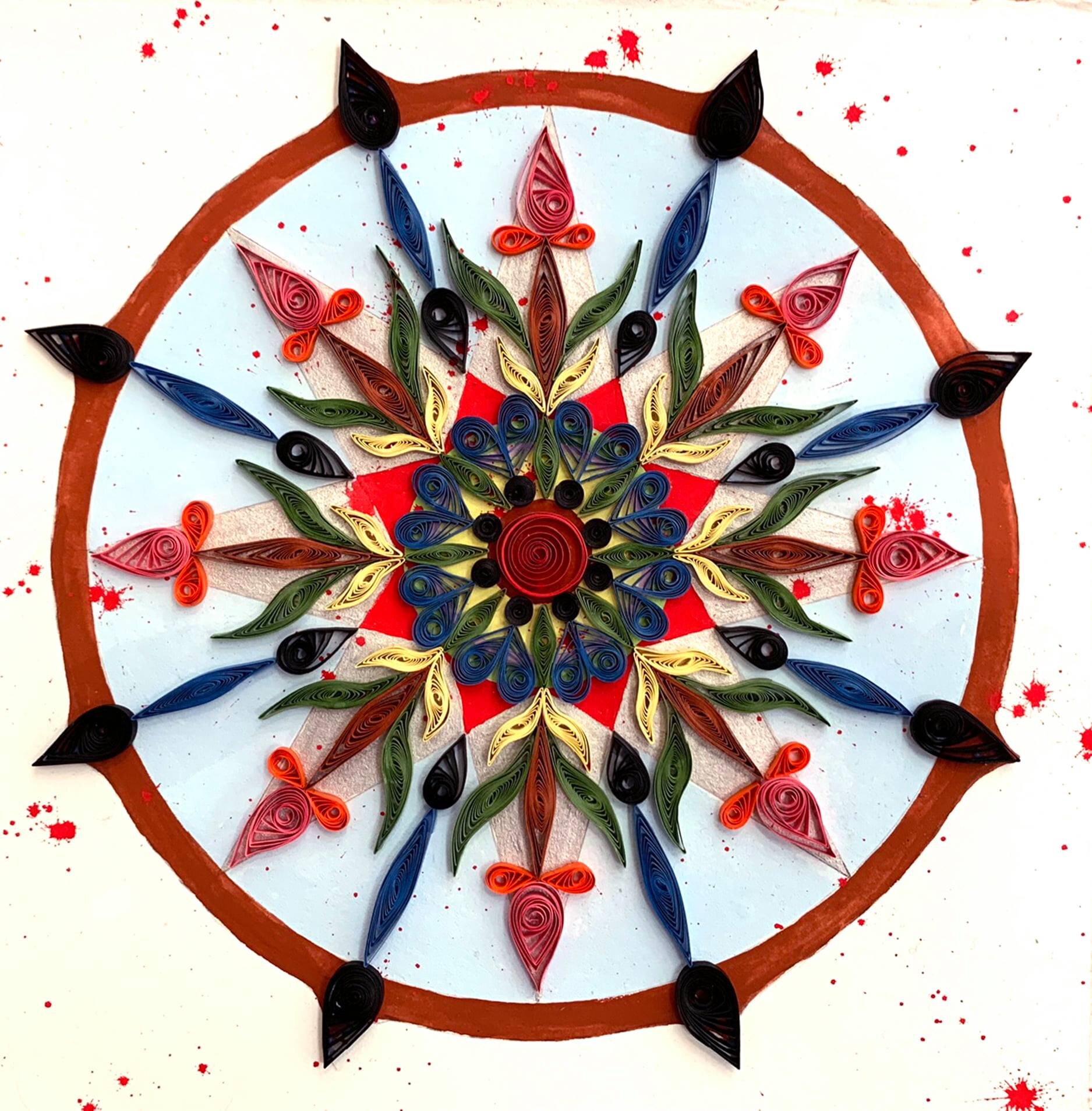Stains Series
Stains Series, gouache, quilling (paper craft), paper, 2020/21
The Stains Series is part of Megan Wilson’s work reflecting on her family’s roots as settler-colonizers in the United States in the context of Manifest Destiny, its misdirection, and its legacy of genocide, inherited and perpetuated trauma, violence, addiction, and the resistance and resilience igniting movements of social/cultural/political change and redirection.
I began creating the Stains Series drawings during the Covid-19 pandemic. Reflecting on my life during this period, including finally having the opportunity to grieve my mother’s death in 2015, my mind kept returning to my family’s history and my childhood growing up in Montana with the challenges I and those close to me faced; however now having the time, space, and a larger social context to place it in.
As I’ve previously noted in talking and writing about my work influenced by growing up as a fifth generation Montanan:
I was surrounded by the mythology and iconography of the American West, and specifically that of the cowboy. Images of rugged men with their code of stoic endurance, self-reliance, loyalty, courage, and camaraderie, on horseback riding across the plains, wrangling cattle and spitting chew were everywhere - from the paintings of Charles M. Russell, Frederick Remington, and Will James to the landscape itself.
However, the reality is the painful and violent history of Manifest Destiny that annihilated much of the Indigenous peoples and wildlife of the West. The 19th century doctrine gave American settlers the rationale of a ‘God-given destiny’ to expand westward across North America and beyond. Framed in the context of morality, divinity, freedom, and the presumed greatness of a white America, the ideology was used to justify the forced removal of Indigenous nations from their land, the subsequent genocide of their peoples, and later, claims to Pacific islands. The mass migration also served industrialists who benefited from the labor force that established in the west to build the railroads, rework the stolen land, build the cities and mine the natural resources.
From these initial personal drawings, my intention is to expand the work, using the concept/history of Manifest Destiny to explore its misdirection and its legacy of genocide, inherited and perpetuated trauma, inherited and perpetuated violence; the resistance, resilience, and redirection to healing. This work is informed in part by my family’s roots as settler colonizers beginning in 1643 on stolen land in what is now Massachusetts and continuing on stolen land in what is now Ohio, Illinois, Iowa, Utah, Idaho, the Dakotas and Montana starting in the 1800’s. It is also informed by my experiences growing up as a full-blown alcoholic by the age of 14, two suicide attempts as a teen, moving out on my own at 16 after a brutal assault by my mother's married, alcoholic boyfriend, working at Burger King 30 hours/wk to support myself while finishing high school, and being taken in by my best friends - two sisters, and their mother, who are Crow/Apsáalooke for weeks at a time.
The Stains Series uses the traditional craft of quilling (paper filigree) to create intricate drawings that evoke 19th century quilt patterns and mandalas set against a stained foundation. The handicrafts of quilling and quilting spread from England to the American colonies and then to the American West. I began quilling as a child when my grandmother passed on the fashionable craft of her childhood to her granddaughter.
The titles of these works reference the trajectory of my ancestors west - and to a path of healing.
Stains Series: Mishawum/Charlestown Massachusetts, quilling (paper craft) on paper, 9” x 9” unframed, 12.5” x 12.5” framed, 2021
Wilson Family History
Based on research through Mormon records Benjamin Wilson (the first of my Wilson ancestors to live on the North American continent) was 7-years-old in 1643 and one of the 100+ orphaned children in England sent to the Massachusetts Colony as a servant to the settlers there. He married Anne Fuller in 1655 at the age of 18. In 1658 he became a freeman (no longer an indentured servant) and drew lots for “wood and commons” in Charlestown, Massachusetts, giving him land stolen from the indigenous Massachusett people. Charlestown was originally called Mishawum by the Massachusett.
Benjamin and Anne’s son Jeremiah Wilson was born in 1665. He and his wife Hannah Beman were early settlers granted 30 acres in Lancaster, Massachusetts, originally known as Nashaway after the indigenous Nashaway tribe from whom the land was taken.
Jeremiah and Hannah’s son Joseph Wilson was born in 1692; he married Rebekah Phelps in 1726. Joseph received land in Nichewaug, later named Petersham, Massachusetts as a reward for murdering the Indigenous peoples for whom the land belonged as part of the “Indian Wars” and genocide waged by the colonists to lay claim to the land and resources.
Joseph and Rebekah’s son Deliverance Wilson was born in 1737. He married Sarah Smith in 1764. He is noted as having participated in the American Revolution.
Deliverance and Sarah’s son Bradley Barlow Wilson was born in Petersham in 1769. He married Mary (Polly) Gill in Springfield, Vermont in 1799.
Bradley and Polly’s son George Clinton Wilson was born in 1800 in Milton, Vermont, the second child of nine, including seven sons and two daughters. In 1822 Bradley and Polly moved and settled with their seven sons in Perry, Richland County, Ohio. All seven of their sons built homes next to one another in Perry. George Clinton married Mary Elizabeth Kinney in 1826 in Franklin, Vermont.
Stains Series: Nashaway/Lancaster Massachusetts, quilling (paper craft) on paper, 9” x 9” unframed, 12.5” x 12.5” framed, 2021
Stains Series: Nichewaug/Petersham Massachusetts, quilling (paper craft) on paper, 9” x 9” unframed, 12.5” x 12.5” framed, 2021
Stains Series: Nikn Tekw Ok/Rindge New Hampshire, quilling (paper craft) on paper, 9” x 9” unframed, 12.5” x 12.5” framed, 2021
Stains Series: Kwanitekw/Springfield Vermont, quilling (paper craft) on paper, 9” x 9” unframed, 12.5” x 12.5” framed, 2021
Framed works (the color is a bit off - the works are all on white paper with white frames)
The Wilson Family‘s history as early members of the Mormon Church
In 1836 Mormon elders Oliver Granger and George Albert Smith visited the Wilsons looking to use the neighborhood schoolhouse for religious services. While most of the families in the area responded to Granger and Smith with threats of violence due to the growing fear and rejection of the Mormons, the Wilson family welcomed the missionaries. All members of the Wilson family were baptized as Mormons on May 3, 1836.
Like other Protestant denominations in America at the time, the Mormon Church was rooted in American imperialism and white supremacy. The Mormons proclaimed the United States as the Promised Land and based their origins on a story claiming the first Americans were a lost tribe from Israel that migrated to the Americas with one branch, the Lamanites cursed by God with dark skin and a degraded existence. The story professes the Lamanites would not regain white skin and a civilized way of life until they accepted the teachings of Christ.
The year of the Wilson family’s baptism, 1836, Bradley, Polly, and their seven sons with their wives and children sold their farms and moved to Tinneys Grove, Missouri, near the early Mormon settlement Far West. In 1838 the Missouri Mormon War erupted between Mormons and non-Mormons leading the Governor of Missouri, Lilburn Boggs to issue Missouri Executive Order 44 in late October, ordering the Mormons to leave the state or be killed. On November 1, 1838 Joseph Smith, the founder of the Church of Latter-day Saints surrendered at Far West, ending the War. Smith was charged with Treason, but escaped. He and the approximately 10,000 remaining Missouri Mormons, including the entire Wilson family fled to Nauvoo, Illinois. In 1844 Joseph Smith and his brother were assassinated by a mob as a result of continued Mormon persecution.
Following the assassination of Smith, the persecution of the Mormons in Nauvoo continued. At one point a mob took George Clinton and Bradley Barlow Jr. as prisoners. After six months of imprisonment, they were able to escape by burning a hole in the floor, then walking sixty miles home.
In 1846 George Clinton Wilson and his brothers Bradley Barlow Jr., and Lewis Dunbar, their wives and children left Nauvoo and resettled first to Bonaparte Iowa, then Garden Grove, and finally Council Bluffs. George Clinton and Mary Elizabeth’s son William Clinton Wilson was born in Richland, Ohio in 1847.
Stains Series: Wintegok/Milton Vermont, quilling (paper craft) on paper, 9” x 9” unframed, 12.5” x 12.5” framed, 2021
Stains Series: Wintegok/Perry Ohio, quilling (paper craft) on paper, 9” x 9” unframed, 12.5” x 12.5” framed, 2021
Stains Series: Ochese/Tinney’s Grove, Far West, Missouri quilling (paper craft) on paper, 12” x 12” unframed, 16.5” x 16.5” framed, 2021
Stains Series: Quashquema/Nauvoo Illinois, quilling (paper craft) on paper, 12” x 12” unframed, 16.5” x 16.5” framed, 2021
Stains Series: Meskwahikihinaki/Garden Grove Iowa, quilling (paper craft) on paper, 12” x 12” unframed, 16.5” x 16.5” framed, 2021
Framed works (the color is a bit off - the works are all on white paper with white frames)
The Wilson Family’s Migration West
In 1853 the three Wilson brothers - George Clinton, Bradley Barlow Jr., and Lewis Dunbar - were part of the Daniel A. Miller/ John W. Cooley Company traveling from Iowa to the Salt Lake Valley. The company included 282 individuals and 70 covered wagons that left Iowa on June 6th and reached Salt Lake City on August 29, 1853.
From the diary of Lewis Dunbar Wilson:
On June 6 th , we left the states for the valley of Great Salt Lake in company of Daniel Miller and J.W. Cooley & Co. Traveled with them four or five weeks and made such poor progress that G[eorge].C. Wilson—B[radley]. B[arlow]. Wilson, two of my brothers and myself, went ahead, and traveled about double the distance a day that we had been in the habit of traveling and passed on for several weeks with out any thing strange occuring. We killed some game along the way and enjoying ourselves first rate being all well and making good progress on our journey. We saw no indians on the road for several weeks. At length we began to come across some of the red men of the west who appeared very civil until we met a band of them who were moving. They passed us civily all but G.E. Wilson’s pony. He had gone back for an antilope that some of the boys had killed. When they went to pass him and his wife in the pony wagon, some of them cut some of their capers and scared the ponies. They spun and slipped the neck yoak [yoke] ring right off of the tongue and both got on one side of the tongue and jerked my brother right off the fore end of the wagon and run over him with the waggon. His wife caught hold of one of the lines and held on to it until they ran around on a small circle when some of the boys ran and caught them as they came around. After all there was not much injury sustained. It hurt my brother some.
So we passed on for some days with out any more molestation. Later we came up to a large camp of them. They came out and formed a line across the road and called us to stand and required some provisions. After giving some little sugar and coffee they consented to let us pass but they followed us and shook their fists and whooped and tried to scare our teams but didn’t succeed.
They followed us to where we camped, some hundred and fifty of them. We had to get supper for about fifty of them to get rid of them. While we were getting supper ready they stole all of our spare [text missing]. From that time on we passed on quite well until we accomplished our journey. We reached the City of the Great Salt Lake Aug. 29th 1852 [1853] and found it a general time of health and prosperity with the exception of a little Indian fuss.
Stains Series: IrucheInro/Kanesville, Council Bluffs Iowa, quilling (paper craft) on paper, 12” x 12” unframed, 16.5” x 16.5” framed, 2021
George Clinton, Lewis Dunbar, and Bradley Barlow Jr. settled in what is now known as Wilson Ward, West of Ogden, which was named after the Wilson family.
In Oct 1853, George Clinton, Lewis Dunbar, and Bradley Barlow Jr. and their families made their home in Ogden, which according to Elizabeth Moyes Woodmansee, the granddaughter of Bradley Barlow Wilson Jr. consisted of four cabins and covered wagons, and they helped to build up the city. As recounted by Woodsmansee:
I can well remember their first home which was a dugout in a mound and they lived there for a number of years until they were able to build a better one which was a two story frame building and it made a real nice home. In the spring of 1858 in response to an order from the Church, they vacated and moved south as far as Provo because of the coming of Johnston's army. Their homes, like others, were prepared to be burned if necessary to prevent the army from taking them. The wheat was hauled from Ogden to Salt Lake City where it was stored. While taking a load of wheat to Salt Lake City one of the oxen fell to the ground and could not go on. They left it there to die. They went on and made camp. That night John G. and grandfather went back to see if the Ox had died. Grandfather said, "John, let us lay our hands upon it." They did and said a short prayer. The ox was able to go back to camp and helped pull the load of wheat the rest of the way to the city. In the fall of 1858 peace was restored between the U.S. Army and the Mormons and they returned to their homes in Ogden. The Wilson brothers, my grandfather and brothers, owned the bottom land west of Ogden along the Weber River, later called Wilson Lane.
My great, great, ,great grandfather George Clinton Wilson
The Mountain Meadows Massacre
In 1857, a group of Mormon settlers in Utah disguised themselves as members of the indigenous Southern Paiute tribe and attacked a wagon train at Mountain Meadows in southern Utah territory. The Mormons believed the wagon train to be a military expedition, sent by President Buchanan prior to troops being sent in; however, the party was actually a group of wealthy settler colonizers from Arkansas emigrating west to California known as the Baker-Fancher party. The party had planned to restock their supplies in Salt Lake City, but were refused and continued on to find water and grazing for their livestock at the grassy, mountain-ringed Mountain Meadows, a widely known stopover on the old Spanish Trail. On September 7, they were attacked by Mormon militiamen dressed as Southern Paiutes. By the end of a five day siege, the Mormons had massacred 120 members of the Baker-Fancher party, leaving only 17 children under the age of seven to survive.
The Mormons attempted to cover up the massacre, claiming it had been instigated and carried out by the Paiutes. While the massacre was investigated by the US government and it was determined the Mormons had played some part in the attack, only one member of the Church, John D. Lee, the Territory’s Indian Agent was held accountable and executed. However, there were members of the Mormon Church who knew the truth and spoke out, these included my great, great grandfather William Clinton Wilson and his wife Mary Ann Western.
Both had been young children when the massacre took place, but the vicious murders and subsequent veil of lies and betrayal stuck with them. At the same time, the fierce vigilance of the Mormon leadership to continue to place blame with the Southern Paiute tribe and downplay the Church’s involvement, led to a target being placed on the backs of William Clinton Wilson, Mary Ann Western Wilson, and their children by the Mormon’s ‘Avenging Angels hit squad. In 1883, the family packed up and headed north to Camas, Idaho; later settling in Idaho Falls.
Stains Series: Pia-pa/Salt Lake City Utah, quilling (paper craft) on paper, 12” x 12” unframed, 16.5” x 16.5” framed, 2021
My great great grandfather William Clinton Wilson, Idaho Falls, Idaho, early 1900's.
The Wilson’s in Idaho: A Family of Outlaws and Dissenters
William Clinton and Mary Ann Western had seven children, including my great grandfather John Arthur Wilson (Jack) who was born in 1880 in Ogden, Utah. The family moved to Eagle Rock Idaho, in 1883; Eagle Rock later became Idaho Falls. Jack met my great grandmother Anna Metzner at a dance that he was playing banjo at as part of the band; they married in 1903 in Idaho Falls. Anna was born in Orpund, Switzerland in 1882; her family migrated to the United States in 1890, fleeing persecution for converting to Mormonism.
Jack and Anna had three children, Jeff (my grandfather), Alice and Bill. The family homesteaded a farm south of Hamer, Idaho, however they returned to Idaho Falls.
My great grandfather Jack and his older brother Bill were bootleggers in Idaho Falls from 1915 – 1926 (prohibition passed in Idaho in 1916). According to my great aunt Lois, they would drive to Canada to purchase the goods and bring it back to sell, mostly to the town's elite businessmen. They also made moonshine in the basement of Jack’s and my great grandmother Anna’s home. A trap door to the basement was located underneath the kitchen sink and every time someone would come to the door there would be a mad dash to close and cover up the trap. Following several raids on their home, my great grandfather moved the family into a tent not far from their home for three years.
Always on the run from the law, Lois recalled one story in which Jack was driving back from Canada with a car full of liquor. He always kept a shotgun wrapped up in a blanket in the back window and during this run the authorities were on his tail shooting at the car. According to Jack, one shot came through the back window and the bullet hit his concealed gun.
The law finally caught up with them in 1926 when the town’s deputy sheriff showed up at Jack's home to arrest him and Bill. Jack had caught wind of this plan beforehand and packed up Anna and their children Jeff (my grandfather), Alice, and William to head out of town. Bill stayed behind and when the deputy arrived Bill shot and killed him on the front lawn. Bill, who had three of the town’s best attorneys (his clients) representing him only received a 5-year sentence in the state penitentiary for the crime.
In addition to being plasterers by trade, the family's legitimate business was the Star Theater in Idaho Falls that Jack and Bill owned with their father, William Clinton.
Jack and Anna divorced in the early 1930’s; however, remained close friends throughout their lives.
In addition to raising three children, much of Anna’s life was spent in home nursing and helping in homes of people who were sick, including working in many homes during the 1918 flu pandemic.
Anna remarried in 1935 to a man named George Gould; he died in 1939. In 1940 she went to work as the matron of the women’s city bathroom, downstairs in Idaho Falls City Hall. Anna was 80 years old when the city closed the restroom. She was upset not to have a job to go to anymore. She spent the next 20 years of her life active in the Relief Society, a volunteer service of Mormon women. She died at the age of 102 in 1984.
Stains Series: Ho-quip/Ogden Utah, quilling (paper craft) on paper, 12” x 12” unframed, 16.5” x 16.5” framed, 2021
My great grandfather Jack Wilson (with banjo), his brother Bill Wilson (next to him on the left with the guitar) and their band in 1902. My father had told me that Jack met my great grandmother Ana at a dance that the band was playing at.
My grandfather Jeff Wilson (in the center), his brother Bill, and his sister Alice in 1917, Idaho Falls.
William Clinton, Bill, and Jack Wilson’s Star Theater, Idaho Falls, Idaho, 2012
My great grandfather Jack Wilson and great grandmother Ana Metzner Wilson, 1903.
My great grandfather Jack Wilson with his banjo, 1930’s
California
Anna’s sister, my great, great aunt Rosina Metzner Martin was a nurse at San Francisco General Hospital on Potrero Street starting in the early 1900’s through the '40's. She and her husband Frank Martin, a barber, lived in the Mission District near the hospital. Frank disappeared in the 1906 earthquake never to be seen again.
In the 1940’s Jack and Bill worked in California as plasterers in Coalinga at F.L. Good Contractor & Builder and in San Francisco as part of the Plasterers & Shophands Union, Local 66. Jack also played banjo throughout his life, sometimes riding the rails as a traveling musician. Jack ended up back in Idaho Falls in the fifties, living in a one room cabin by the river. He died by suicide in 1962 at the age of 82.
My great, great aunt Rosina Metzner Martin with her husband Frank, who was killed in the San Francisco earthquake of 1906.
Jeff Wilson - the Wilson Family Dissident Who Left the Mormon Church
My grandfather Jeff Wilson was born 1908 in Idaho Falls. At the age of 17 Jeff challenged his Mormon Church elders by citing the Mountain Meadows Massacre when they claimed the Mormons had always been a peaceful people. My grandfather knew about the massacre from oral history passed on through our family. The church elders denied the Mormons had played any role in the massacre, instead attributing it to the Southern Paiutes. They told my grandfather if he believed otherwise, then he ought leave the church. My grandfather turned his back on the Mormon Church and never returned. According to my father, my grandfather had had enough of the church, its lies, and its hypocrisy, including what he had witnessed directly with his own his father and uncle being bootleggers and alcoholics, putting the family in constant danger.
My grandfather was accepted into Stanford University for college and my great, great aunt Rosina, who was living in San Francisco offered to pay for his tuition; however, he needed to stay in Idaho Falls and help take care of the family, which Jack had abandoned. He took a job with the telephone company, later transferring to Montana, where he met my grandmother Eugenie (Jean) Kemp through her father, my great grandfather Harry Kemp. Jeff and Harry both belonged to a shooting club. Harry noted that Jeff was an exceptional sharpshooter; almost as good as his daughter, my grandmother, so he set them up on a date. Jeff and Jean married in 1935, first settling in Billings, and later Miles City.
My grandfather Jeff Wilson, 1920’s



























